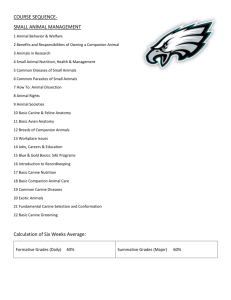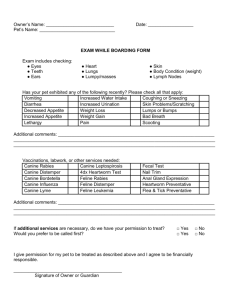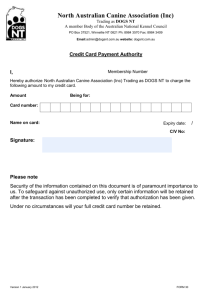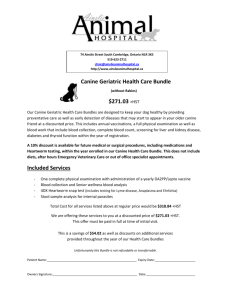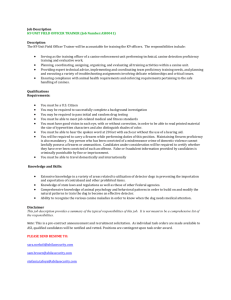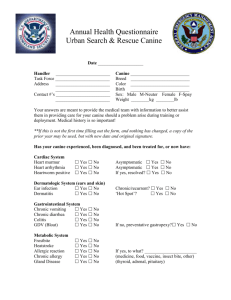Canine Medicine - Australian College of Veterinary Scientists
advertisement
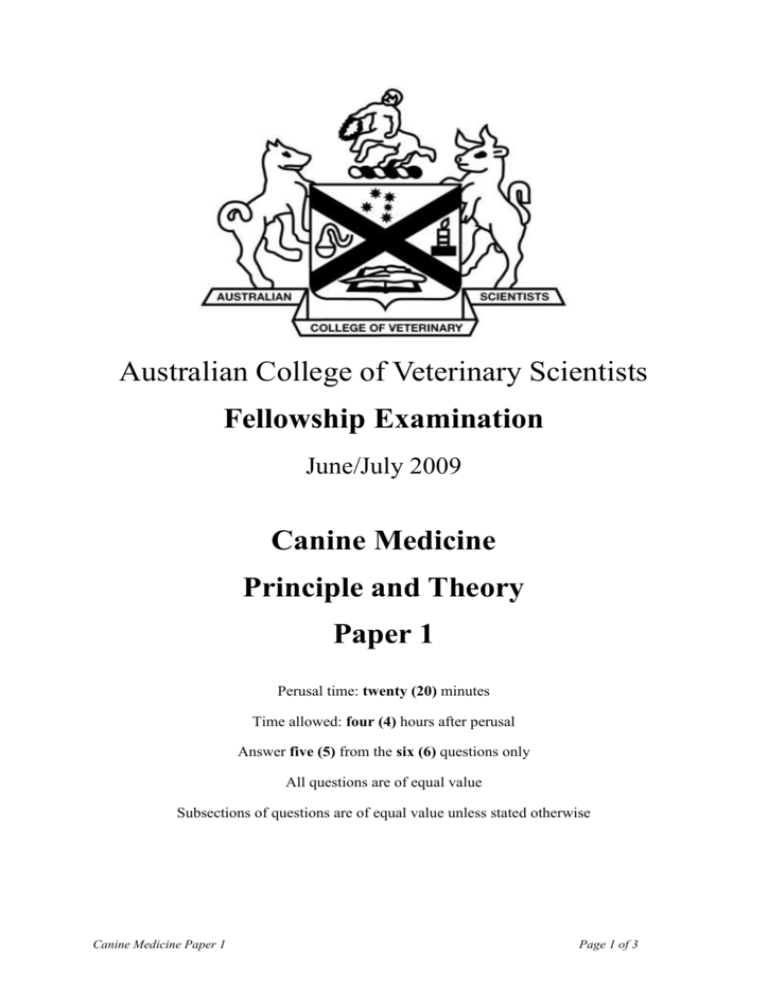
Australian College of Veterinary Scientists Fellowship Examination June/July 2009 Canine Medicine Principle and Theory Paper 1 Perusal time: twenty (20) minutes Time allowed: four (4) hours after perusal Answer five (5) from the six (6) questions only All questions are of equal value Subsections of questions are of equal value unless stated otherwise Canine Medicine Paper 1 Page 1 of 3 Paper 1: Canine medicine Answer five (5) from the six questions only. 1. Answer all of the following: a) Define proteinuria and microalbuminuria. Explain how these are detected in dogs. b) Summarise the clinical significance of microalbuminuria in dogs based on evidence from published literature. c) Explain the key characteristics of an excellent screening test. d) State whether or not the detection of microalbuminuria in dogs satisfies the criteria for an excellent screening test, and explain your reasoning. 2. Discuss the pathogenesis (60%) and clinical diagnosis (40%) of disseminated intravascular coagulation. 3. Write notes on three (3) of the following: a) the pathogenesis of anaphylaxis b) the production, composition and fluid dynamics of cerebrospinal fluid in the normal dog c) cavernous sinus syndrome d) the pathogenesis of hereditary myotonia in dogs. 4. Outline the lifecycle of the protozoan parasite, Neospora caninum, and the pathogenesis, clinical manifestations and clinical diagnosis of neosporosis in the dog. Continued over page Canine Medicine Paper 1 Page 2 of 3 5. Discuss two (2) of the following: a) the principles and practice of ‘metronomic chemotherapy’ (continuous low-dose chemotherapy) in dogs. b) the environmental risk factors for cancer in dogs c) the mechanisms of acquired chemotherapy resistance in cancer cell lines. 6. Bacterial urinary tract infections in dogs may be simple (or uncomplicated) or complicated. A recurrent bacterial urinary infection may be a relapse or a reinfection. Answer all of the following: a) Explain the terms above in italics, as they are used to describe bacterial urinary tract infections in dogs. b) Indicate why it is considered clinically useful to distinguish a relapse from a reinfection. c) Antimicrobial susceptibility test results have been used to distinguish between a relapse and a reinfection. Explain the limitations of this approach and why it can be unreliable. d) Briefly describe the mechanisms by which uropathogenic bacteria may acquire fluoroquinolone resistance. End of paper Canine Medicine Paper 1 Page 3 of 3 Australian College of Veterinary Scientists Fellowship Examination June/July 2009 Canine Medicine Applied Paper 2 Perusal time: twenty (20) minutes Time allowed: four (4) hours after perusal Answer five (5) from the six (6) questions only All questions are of equal value Subsections of questions are of equal value unless stated otherwise Canine Medicine Paper 2 Page 1 of 3 Paper 2: Canine medicine Answer five (5) from the six (6) questions only. 1. Several blood tests are currently available to aid in the diagnosis of exocrine pancreatic diseases of the dog. Discuss the value and limitations of these blood tests for the diagnosis of canine exocrine pancreatic disease. Pay particular attention to an evidence-based critique of the performance of the canine pancreas-specific lipase assay. 2. Discuss your differential diagnoses, diagnostic approach and clinical management in the dog presenting with hypoglycaemia. 3. In recent years, the American Animal Hospital Association and World Small Animal Veterinary Association have issued guidelines for the use of vaccines in puppies and adult dogs. With respect to these recently published canine vaccination guidelines, answer all of the following: a) Define the term ‘core vaccine’ as it is used in these documents. Summarise the scientific evidence available to support or refute the contention that ‘core’ vaccines protect for at least three years. (40%) b) Explain the strengths and limitations of serological tests (ie measurement of serum antibody titres) for assessing the duration of immunity against canine distemper, infectious canine hepatitis and canine parvoviral enteritis. (20%) c) Discuss the strengths and weaknesses of challenge studies for assessing the duration of immunity against canine distemper, infectious canine hepatitis and canine parvoviral enteritis. (20%) d) One recommendation that surprised and dismayed some readers of the guidelines was that the final puppy vaccination should be given no earlier than 14 weeks of age and preferably at 16 weeks of age or later. Explain the basis for this recommendation and why it caused dismay for some readers. (20%) Continued over page Canine Medicine Paper 2 Page 2 of 3 4. The current (2005) edition of Ettinger and Feldman’s Textbook of Veterinary Internal Medicine outlines triple drug therapy of frusemide, an angiotensin-converting enzyme inhibitor, and digoxin as ‘the mainstay of treatment for dogs with congestive heart failure’, whether secondary to degenerative valve disease or dilated cardiomyopathy. Discuss your approach to the management of stable congestive heart failure secondary to these diseases in dogs, explaining your rationale for any deviation from the above recommendation. 5. Write notes on three (3) of the following: a) antioxidant therapy in chronic inflammatory liver disease b) strategies additional to glucocorticoid therapy to improve the outcome of canine primary immune-mediated haemolytic anaemia c) the indications, techniques and potential complications of cerebrospinal fluid collection d) your preferred medical management of canine idiopathic non-suppurative meningoencephalitis. 6. Discuss two (2) of the following: a) the use of inhaled aerosol medications in canine respiratory disease b) the treatment of canine sinonasal aspergillosis c) the investigation and management of aspiration pneumonia in a 10-year-old male neutered labrador retriever. End of paper Canine Medicine Paper 2 Page 3 of 3
